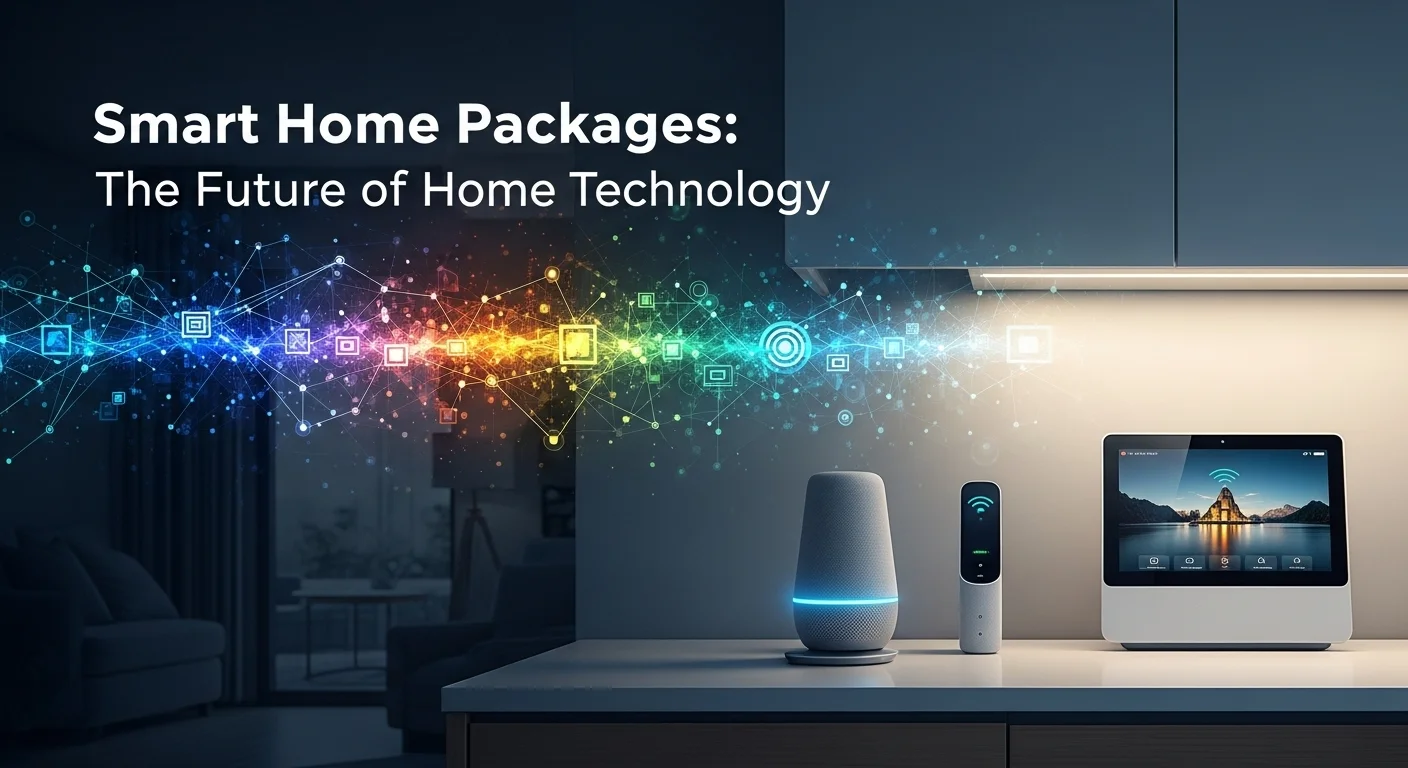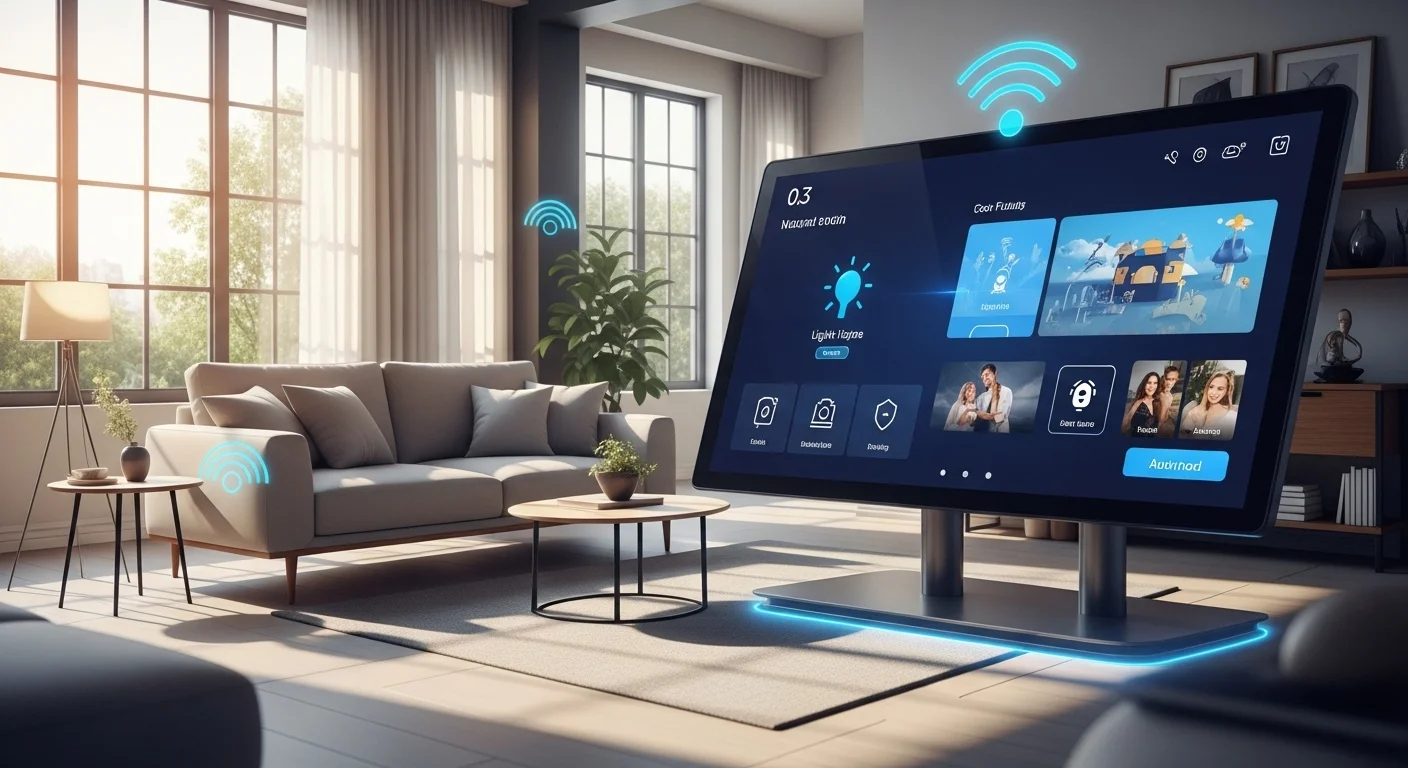Smart Home Packages Explained: A Guide to a Truly Connected Life

Executive Summary
I remember my first smart home setup – a frustrating mess of different apps and gadgets that barely spoke to each other. It was more work than it was worth. That's why I'm so passionate about 'Smart Home Packages.' This is a game-changing approach where everything—lighting, security, climate, and entertainment—works together as one intelligent system. This article is my personal guide to understanding these unified packages. We'll explore why they're not just a cool convenience for your house but also a powerful efficiency tool for businesses. I'll break down the core components you need, compare the big players in the market, and give you a clear roadmap to choosing the right setup. Think of this as your entry point to transforming your space from a collection of gadgets into a truly responsive environment, making your life and work simpler, safer, and more intuitive.
Table of Contents
Table of Contents
- What Are Smart Home Packages and Why Do They Matter?
- The Key Components of a Complete Smart Home System
- Why Smart Home Packages Are a Game-Changer for Businesses
What Are Smart Home Packages and Why Do They Matter?
In the tech world, we love our buzzwords, but 'Smart Home Package' is one that actually means something important. So, what is it? Simply put, it's a complete collection of smart devices designed from the ground up to work together as a single, cohesive team. This is a huge step up from the early days of smart tech, where you might have had a smart thermostat from one brand and smart lights from another, each trapped in its own app. A full smart home package changes that. It's built around a central 'brain'—a hub or controller—that directs a whole ecosystem of devices. We're talking about everything from your lights and thermostat to security cameras, door locks, and even your speakers. The goal isn't just to control things with your phone; it's to create an environment that automates tasks, boosts security, saves energy, and just makes life easier.
From my experience, the importance of these integrated systems is massive. They're where several major technologies—the Internet of Things (IoT), AI, and cloud computing—all come together in your living room or office. Every device in a smart home system package is a mini-computer collecting and sending data. The AI is the magic layer that learns your routines. For example, I have my system set up so it learns my family's temperature preferences, automatically adjusting the thermostat to save energy without anyone having to touch it. This is the future: systems that don't just react to your commands but anticipate your needs. This isn't just for homes, either. I've worked with many small businesses that have seen real benefits. An effective home automation package in an office or shop can automate lighting to cut electricity bills, beef up security with smart locks, and streamline daily operations. Imagine getting an alert if a stockroom door is opened after hours, or having the entire building shut down and lock up automatically when the last person leaves. This level of control used to cost a fortune, but now it's accessible to almost any business owner.
The Key Components of a Complete Smart Home System
To really get what makes these packages so powerful, you have to know what's inside. A typical full smart home package includes a few key ingredients that all work in harmony.
- The Hub (The Conductor): This is the heart of your system, the conductor of your smart home orchestra. It could be a dedicated box like a SmartThings Hub or built right into a smart speaker like an Amazon Echo or Google Nest Hub. It tells all your other devices what to do and when to do it, running the automations you've set up, like a 'Good Morning' routine that gently fades up the lights and starts the coffee maker.
- Smart Lighting: This is the gateway for many people. It's more than just colored bulbs; it includes smart switches and dimmers that let you schedule your lights or create the perfect mood for a movie night. It's one of the first things I recommend because the impact is immediate and impressive.
- Climate Control: Smart thermostats from brands like Nest and Ecobee are a must-have. I've seen them cut energy bills significantly just by learning a household's schedule. This category also includes smart fans and automated blinds that work together to keep your home comfortable and efficient.
- Security and Access: This is a huge one for peace of mind at home and for asset protection at a business. A good smart home system package will bundle video doorbells, security cameras, smart locks, and motion sensors. These tools let you see who's at your door from anywhere in the world and can even trigger other actions, like turning on all the lights if motion is detected in the backyard at night.
- Entertainment: Your smart package can extend to your fun, too. Multi-room audio from Sonos or smart TVs with voice assistants let you control your media effortlessly. I have a 'Party Mode' that plays a specific playlist in every room with a single command. It's simple, but it feels like living in the future.
- The App (The Control Panel): Finally, the software that ties it all together. A well-designed app gives you one place to control everything, create routines, and see what's happening at a glance. This unified interface is what separates the best smart home packages from a simple collection of gadgets.
Why Smart Home Packages Are a Game-Changer for Businesses
While 'Home' is in the name, the business applications are where I've seen some of the most impressive results. The same tech that makes your house convenient can make an office, shop, or restaurant incredibly efficient. For a small business, a smart home full package is like having an affordable, 24/7 operations manager. Think of a small coffee shop. The owner can set an 'Open' scene that turns on the lights, adjusts the thermostat, fires up the espresso machine, and switches on the music. At the end of the day, a 'Close' scene secures the premises, shuts everything down, and arms the security system, reducing the chance of human error. Energy savings are another huge win. Businesses use a lot of power, and smart sensors can ensure lights and heating are only on in occupied areas, leading to major cost reductions. Security is also non-negotiable. With a smart home system package, I've helped business owners ditch old-fashioned keys for smart locks, giving them a digital log of who enters and when, and the ability to grant temporary access to cleaners or delivery drivers remotely. This technology is incredibly versatile and offers a tangible return for any business looking to work smarter, not harder.

Your Complete Guide to Smart Home Tech and Business Solutions
Getting started with a smart environment for your home or business is an exciting journey, but it requires a bit of planning. It’s about more than just buying cool gadgets; it’s about choosing the right foundation. This guide is my roadmap to help you navigate the technical details, business strategies, and comparisons you'll need to pick the best smart home packages. Making an informed choice from the start is the key to building a system that’s not just clever, but also reliable, secure, and ready for the future. Let’s build an ecosystem that truly delivers long-term value from your full smart home package.
The Tech Behind the Magic: Protocols and Ecosystems
The secret sauce of any smart home is how the devices talk to each other. This is done through wireless languages called protocols. You don't need to be an engineer, but knowing the basics helps a lot.
- Wi-Fi: Everyone knows Wi-Fi. It's great for things that need a lot of data, like security cameras. The downside is that it can be power-hungry for battery-powered devices, and too many Wi-Fi gadgets can clog up your network.
- Zigbee and Z-Wave: Think of Wi-Fi as a busy public highway. Zigbee and Z-Wave are like dedicated, private lanes built just for your smart devices. They create a 'mesh' network where devices can pass signals along, making the network stronger and more reliable. They also operate on a different frequency, so they don't interfere with your Wi-Fi. Many of the best hubs support both.
- Bluetooth Low Energy (BLE): As the name implies, this protocol sips power, making it perfect for small, battery-operated sensors that don't need to be online constantly.
- Matter: This is the new kid on the block, and it's a big deal. Matter isn't a protocol itself, but a universal language that allows devices from different brands to work together seamlessly. My strong advice: for future-proofing your smart home full package, look for the Matter logo. It's backed by Apple, Google, and Amazon, and it's simplifying everything.
Once you have a feel for the tech, you need to choose your team captain: the main ecosystem you'll use. The three giants are:
- Amazon Alexa: The king of compatibility. Alexa works with an incredible number of devices. If you love tinkering and want the widest possible selection, this is often the way to go. Its Echo speakers are a super accessible starting point.
- Google Home (Nest): If you already live in Google's world (Gmail, Calendar, etc.), this ecosystem feels incredibly natural. Google Assistant is fantastic at understanding conversational commands, and its Nest Hub devices offer a great visual dashboard for your home.
- Apple HomeKit: For those of us in the Apple ecosystem, HomeKit is the gold standard for security and privacy. It's known for being incredibly locked down and secure. Historically, it had fewer compatible devices, but Matter is changing that fast. Control is beautifully integrated into your iPhone, right in the Home app.
For a business, the choice often comes down to security needs or existing tech. An IT-focused company might lean towards HomeKit's security, while a retail shop might prefer the affordability and variety of the Alexa ecosystem.
Smart Business Moves: Using Automation for Real ROI
For a business, a home automation package isn't a toy—it's an investment. To get a real return (ROI), you need to be strategic:
- Slash Energy Bills with Smart Data: First, use your new system as an intelligence-gathering tool. Smart plugs and thermostats will show you exactly where your money is going. Use that data to create smart rules, like making sure every non-essential piece of equipment powers down the second you close for the day. I've seen businesses cut their utility bills by 20-30% this way.
- Boost Security and Prevent Loss: A security-focused smart home system package can pay for itself by preventing a single incident. Ditching physical keys for smart locks eliminates the risk of lost or copied keys and gives you a full audit trail. Cameras not only deter theft but provide invaluable evidence if something does happen. Many insurers even offer discounts for these systems.
- Automate the Busywork: Time is your most valuable resource. Automate the repetitive stuff so your team can focus on what matters. This can be as simple as programming the lights and music in a restaurant or as advanced as using sensors to monitor stock levels. In my own home office, I have a 'Focus Mode' that adjusts the lights, plays ambient sound, and silences notifications on my devices.
- Create a 'Wow' Experience: Technology can make your space more inviting. In a client's waiting room, using a smart system to set the perfect lighting and temperature creates a fantastic first impression. For employees, a comfortable, well-lit environment is a proven boost to morale and productivity.
- Protect Your Assets: Beyond theft, a full smart home package can save you from disaster. I installed a simple water leak sensor under a sink for a client that saved them from a catastrophic flood by sending an alert to their phone the moment a pipe started dripping. This kind of predictive protection is priceless.
Choosing Your Path: Resources and Key Comparisons
The smart home world can feel overwhelming, but great resources are out there. Tech sites like The Verge and YouTube reviewers like MKBHD offer fantastic real-world reviews of the best smart home packages. For a business, I often recommend talking to a professional installer. They can design a system that’s perfectly tailored to your space.
When you're comparing your options, here's a checklist I use:
- DIY vs. Pro Install: DIY is cheaper upfront and gives you flexibility, but it takes time and some technical skill. For a complex business setup or if you just want it done right, a professional installation is often worth the investment.
- Upfront vs. Subscription Costs: Be careful here. Some systems have cheap hardware but lock you into a monthly fee for cloud storage or key features. Always calculate the total cost of ownership over a few years.
- Can It Grow With You?: Don't get locked into a closed system. Choose a platform that supports standards like Matter to ensure you can add new devices in the future, regardless of the brand.
- Security and Privacy: This is my number one priority. Read the privacy policy. How does the company handle your data? Look for strong encryption and two-factor authentication. For a business, this is non-negotiable.
By thinking through the tech, focusing on real-world business benefits, and doing your homework, you can build a smart home full package that's powerful, effective, and truly improves how you live and work.

Tips and Strategies to Master Your Smart Home Package
Getting your smart home system package installed is just the beginning. The real magic happens when you start to fine-tune it. To get the most out of your investment, you need to focus on security, get creative with advanced automation, and know where to turn for reliable information. These are my go-to tips and best practices for making your home automation package not just smart, but secure, efficient, and perfectly in sync with your life and work.
Lock It Down: Best Practices for a Secure Smart System
The convenience of a connected world comes with a responsibility to keep it secure. Your smart home is a castle, and your router is the main gate. Let's make sure it's locked tight. Hackers are actively targeting these devices, so security can't be an afterthought.
- Fortify Your Wi-Fi Network: Everything starts here. The first thing I do in any setup is change the router's default admin username and password. Use a strong, unique password for your Wi-Fi and enable WPA3 encryption if you can. For an extra layer of protection, I highly recommend creating a separate guest network for visitors and, if your router allows, a dedicated network just for your smart devices. This isolates them from your computers and phones, where your most sensitive data lives.
- A Unique Password for Everything: I can't stress this enough. Never reuse passwords. Too many devices still ship with default passwords like 'admin' that are an open invitation for trouble. Use a password manager to create and store complex passwords for every single account in your full smart home package.
- Turn On Two-Factor Authentication (2FA): If a service offers 2FA, use it. It's one of the most effective security measures you can take. It means that even if someone steals your password, they can't get into your account without a second code, usually from your phone.
- Keep Everything Updated: Tech companies regularly release software updates to patch security holes. Set your devices to update automatically whenever possible. If you can't, make a calendar reminder to check for updates for your hub, cameras, and other critical devices once a month. An outdated device is a vulnerable device.
- Be a Permissions Skeptic: When you set up a new app or device, question the permissions it asks for. Does your new smart bulb really need access to your phone's contacts? Probably not. Only grant the permissions that are absolutely necessary for it to function.
- Know Where Your Data Goes: Some systems, like Apple HomeKit, do a lot of their processing locally on your own network, which is generally more secure. Others rely heavily on the cloud. Take a few minutes to understand how your chosen system works and review the manufacturer's privacy policy.
Unlocking Genius Mode: Advanced Automation and AI
Once you're secure, it's time to have some fun. The real genius of the best smart home packages is in creating automations that make your environment feel alive.
- Build Powerful Scenes and Routines: Think beyond 'lights on, lights off.' I have a 'Movie Night' scene that dims the lights to a soft glow, lowers the smart blinds, turns on the TV and sound system, and bumps the thermostat up a degree—all with one voice command. A 'Goodbye' routine can arm your security, turn off every light, lock the doors, and set your thermostat to an eco-friendly mode automatically.
- Let Sensors Be Your Triggers: The smartest automations are the ones you don't have to think about. Use motion sensors to light up a hallway at night and then turn the lights off when it's empty. Use door sensors not just for security, but to tell your thermostat to turn off if a window is left open. I have water leak sensors in my basement that will send an alert straight to my phone at the first sign of trouble.
- Embrace the AI: Let the system learn. Modern platforms use AI to adapt to your life. Let your smart thermostat run on its own for a couple of weeks; I guarantee its AI-powered schedule will save more energy than a manual one. My security cameras use AI to tell the difference between a person, a car, and a raccoon, so I only get alerts that actually matter. This is a key feature in the best smart home packages.
- Connect to the Web with IFTTT: Services like IFTTT (If This Then That) are like a universal translator for your smart home and the internet. You can create amazing connections. For example, you could set your lights to flash blue when you get an important email from your boss or have your smart speaker announce a calendar reminder 10 minutes before a meeting.
- Tailor Automation for Business: For a business, this gets even more powerful. I helped a restaurant client set up their smart home system package to automatically change the lighting and music playlists to create a different atmosphere for their lunch and dinner crowds. An office can sync its system with the company calendar to automatically prepare a meeting room's AV equipment moments before a scheduled call.
Essential Tools and Quality External Resources
For businesses managing a smart home full package, tools like network monitors can help keep an eye on the system's health. But for everyone, staying informed is key. The tech is always evolving. A fantastic resource I follow is the Connectivity Standards Alliance (csa-iot.org), the organization that manages the Matter protocol. Their site has the latest on the standard and certified products. Keeping up with them ensures that any investment you make in home automation packages today will still be smart tomorrow. By combining strong security habits with creative automation and a commitment to staying informed, you can elevate a simple set of gadgets into a powerful ecosystem that truly makes your life and work better.
Expert Reviews & Testimonials
Sarah Johnson, Business Owner ⭐⭐⭐⭐
This was a good overview of smart home packages, but as a small business owner, I was hoping for more concrete case studies or financial examples.
Mike Chen, IT Consultant ⭐⭐⭐⭐
As an IT consultant, I found the technical comparisons really solid. It's a great starting point for anyone new to the topic, though a deeper dive on network security would be a plus.
Emma Davis, Tech Expert ⭐⭐⭐⭐⭐
Fantastic and thorough guide! This perfectly breaks down smart home packages from all angles. It's exactly the kind of clear, comprehensive resource I was looking for. Highly recommend!



